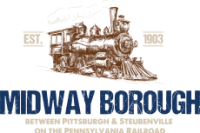EARLY HISTORY
The earliest history available pertaining to the present Borough of Midway dates back forty or more years before the outbreak of the Civil War.
In the seventeen hundreds, the Iroquois, Shawnee and Delaware Indians roamed this part of the country. Numerous of the early settlers built forts to which they could flee when necessity warranted.
Among the old forts in this locality were:
- Allen’s Fort, built before 1774 by John Allen, near the line between Smith and Robinson townships; in the vicinity of Beelor’s Fort.
- Beelor’s Fort, built in 1774 by Captain Samuel Beelor. It was a two-story log cabin which stood about 100 yards southwest of the Raccoon Presbyterian Church in Candor. Captain Beelor was one of the first settlers in Robinson and the fort was frequently used as a refuge for the settlers of that region during Indian raids.
GENERAL HISTORY
The Borough of Midway is situated at the head of Robinson’s Run on the boundary line between Smith and Robinson Townships and was formed from parts of both. It derived the name Midway from its location on the Pennsylvania Railroad, formerly the Cincinnati, Chicago and St. Louis Railroad, 22 miles east of Steubenville, Ohio and 22 miles west of Pittsburgh. It is also 16 miles north of Washington. For forty years, or more, prior to the Civil War, a village known as Egypt was located at this place.
In the year 1865 the railroad was completed and began operations between Pittsburgh and Steubenville. Ohio. It was then known as the Pittsburgh, Cincinnati, Chicago and St. Louis Railroad.
Midway was incorporated into a borough February 9, 1903. The members of the first council were David G. Bamford, president; W.T. Kerr was the first secretary, and council members were F.C. Sawhill, R.M. Dickson and Eugene Wade. George H. Powelson was the first justice of the peace.
The new borough had 120 freeholders and was cut from Robinson and Smith Townships.
At the time the railroad was built through Midway, the present water arch was used as the main thorough-fare from Candor. The bottom of the arch was covered with stones through which the water from the small branch of Robinson’s Run flowed. The persons who traveled by foot made their way through by jumping the stones, and those in buggies or wagons splashed through, much in the manner of fording a creek. At the same time, the small arch near the old mill was built.
CONRAIL TRAIN WRECK
On the night of July 24th, 1980, at approximately 7:05 pm, a Conrail train, derailed while traveling through Midway. The final outcome was a fourteen-car- derailment that triggered the response and cooperation of a network of Emergency Management Services from the entire county. A number of fire companies and ambulance services and one helicopter responded to the scene within one and one half hours of the derailment.
The cause for concern and the need for the response was the derailment of three tank cars. Two of these tank cars were labeled “Chlorinated Solvents” and contained chloroform. One of these had two puncture “wounds” and was the major cause of the vapors and spill. The third tank car was an empty Liquid Propane Gas car. The scene was handled with little confusion due to the Hazardous Material training and planning completed by Engine Company 13 of Midway.
Nine victims were overcome by the vapors and were transported from the scene by ambulance or helicopter. All recovered. Most of the residents of town were evacuated. The greatest concern was that the chloroform would seep into the storm drains and enter Robinson Run as well as into the streets, businesses and homes. The chloroform seeped into the ground water, and for many months thereafter, contaminated groundwater was pumped from beneath the town and disposed of as hazardous waste.

